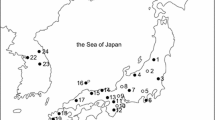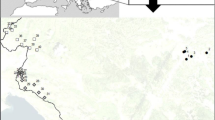Abstract
We have investigated the genetic population structure within and the genetic differentiation between local populations of the large blue butterfly Maculinea alcon throughout the Jutland peninsula. Samples were collected as eggs on foodplants (Gentiana pneumonanthe), and reared to 4th instar caterpillars in the laboratory. A significant excess of homozygotes was found for all the investigated allozyme loci in most of the populations. A North-South cline was observed for the allele frequencies at some of the loci and for several linkage groups. Because some of the allele frequency clines were parallel to clines in adult morphological variation, we interpret our results as evidence for the co-existence of at least two gene pools within the Danish Maculinea alcon populations. Multilocus electrophoretic data revealed highly positive but variable FST values, which under this scenario would reflect varying frequencies of the Maculinea gene pools across the local populations. The significantly positive FIS values indicate that these gene pools are at least partly reproductively isolated (Wahlund effect). The co-occurrence of several Maculinea alcon gene pools on many local sites in Jutland is of great importance for conservation of the fragmented Maculinea populations. Our results show that there is probably more Maculinea biodiversity to conserve than was previously thought, and suggests that extant populations are more fragmented and vulnerable than counts of flying adults or eggs on foodplants indicate.
Similar content being viewed by others
References
Brakefield, P.M. and Shreeve, T. (1992) Diversity within populations. In The Ecology of Butterflies in Britain. (R.L.H. Dennis, ed.) pp. 178–96. Oxford: Oxford University Press.
Ehrlich, P.R. and Murphy, D.D. (1987) Conservation lessons from long-term studies of checkerspot butterflies. Conserv. Biol. 1(2), 122–31.
Elmes, G.W. (1991) Mating strategy and isolation between the two forms, macrogyna and microgyna, of Myrmica ruginodis(Hym. Formicidae). Ecol. Entomol. 6, 411–23.
Elmes, G.W. and Thomas, J.A. (1992) Complexity of species conservation in managed habitats: interaction between Maculineabutterflies and their ant hosts. Biodivers. Conserv. 1, 155–69.
Elmes, G.W. and Wardlaw, J.C. (1982) A population study of the ants Myrmica sabuletiand Myrmica scabrinodisat two sites in the South of England. II. Effect of above-nest vegetation. J. Anim. Ecol. 51, 665–80.
Elmes, G.W., Wardlaw, J.C. and Thomas, J.A. (1991) Larvae of Maculinea rebeli, a large-blue butterfly and their Myrmica host ants: patterns of caterpillar growth and survival. J. Zool. London 224, 79–92.
Elmes, G.W., Thomas, J.A., Hammerstedt, O., Munguira, M.L., Martin, J. and van Der Made, J.G. (1994). Differences in host-ant specificity between Spanish, Dutch and Swedish populations of the endangered butterfly, Maculinea alcon (Denis et Schiff.)(Lepidoptera). Memorabilia Zoologica 48, 55–68.
Erhardt, A. (1985) Diurnal Lepidoptera: Sensitive Indicators of Cultivated and Abandoned Grassland. J. Appl. Ecol. 22, 849–61.
Feltwell, J. (1995) The Conservation of Butterflies in Britain. Battle, UK: Wildlife Matters.
Fiedler, K. (1989) European and North West African Lycaenidae(Lepidoptera) and their association with ants. Journal of Research on the Lepidoptera 28(4), 239–57.
Geiger, H.J. and Scholl, A. (1985) Systematics and evolution of holarctic Pierinae(Lepidoptera). An enzyme electrophoretic approach. Experientia 41, 24–9.
Goudet, J. (1995) Fstat version 1.2: A computer program to calculate F-statistics. Journal of Heredity 86, 485–6.
Hansen, K. (1988) Dansk feltflora. Copenhagen, Denmark: Gyldendal.
Hartl, D.l. and Clark, A.G. (1989) Principles of Population Genetics. Sunderland, Massachusetts: Sinauer Associates, Inc. Publishers.
Hillis, D.M. and Moritz, C. (1990) Molecular Systematics. Sunderland, Massachusetts: Sinauer Associates, Inc. Publishers.
Hunt, W.G. and Selander, R.K. (1973) Biochemical genetics of hybridization in European house mice. Heredity 31(1), 11–33.
Høegh-Guldberg, O. (1973) Aricia artaxerxesF. ssp horkeiH.-Guld. (Lep. Rhopalocera). Description of the preliminary stages and a crossing with A.a. ssp. rambringiH.-Guld. Ariciastudies No. 13. Ent. scand. 4(3), 225–32.
Høegh-Guldberg, O. (1974) Polymorphism in Aricia(Lep. Rhopalocera) in the field and laboratory. (Ariciastudies No. 15). Natura Jutlandica 20, 99–121.
Høegh-Guldberg, O. (1981) A cooling experiment with an F1 generation of Polyommatus icarusf. melanotoxa(Lepidoptera: Lycaenidae). Entomologica scandinavica suppl. 15, 286–92.
Høegh-Guldberg, O. and Lindebo Hansen, A. (1977) Phenotypic wing pattern modification by very brief periods of chilling of pupating Aricia artaxerxes vandalica(Lycaenidae). Ariciastudies No. 16. Journal of the Lepidopterists’ Society 31, 223–31.
Jarvis, F.V.L. (1974) The biological relationship between two sub-species of Aricia artaxerxes(F) and temperature experiments on an F2 generation and on A. artaxerxes ssp. salmacis. Natura Jutlandica 20, 121–9.
Jelnes, J.E. (1975a) Isoenzyme heterogeneity in Danish populations of Aricia artaxarxes(Lepidoptera, Rhopalocera). Hereditas 79, 47–52.
Jelnes, J.E. (1975b) Isoenzyme heterogeneity in Danish populations of Aricia agestis(Lepidoptera, Rhopalocera). Hereditas 79, 53–60.
Kaaber, S. (1964) Studies on Maculinea alcon(Schiff.)-rebeli (Hir.)(Lep. Lycaenidae) with reference to the taxonomy, distribution, and phylogeny of the group. Entomologiske Meddelelser 38, 277–319.
Kaaber, S. and Nielsen, O.F. (1988) 30 Års forandringer i Ryegnens dagsommerfuglefauna. Flora og Fauna 94. Århus, 95–110.
Kudrna, O. (1990). Butterflies of Europe. Wiesbaden: AULA-Verlag.
Marktanner, T. (1985) Die Bedeutung des Schwalbenwurzenzians als Futterpflanze von Maculinea alcon (Lep.: Lycaenidae) im oberschwäbischen Alpenvorland und die Verbreitung der Lycaenidae in diesem Raum. Entomologische Zeitschrift 95(18), 257–72.
Pullin, A.S. (1995). Ecology and Conservation of Butterflies. London: Chapman & Hall.
Raymond, M. and Rousset, F. (1995) GENEPOP (version 1.2): A population genetics software for exact tests and ecumenicism. Journal of Heredity 86, 248–9.
Richardson, B.J., Baverstock, P.R., and Adams, M. (1986) Allozyme electrophoresis-A Handbook for Animal Systematics and Population studies. San Diego, California: Academic Press Inc.
Selander, R.K., Smith, M.H., Yang, S.Y., Johnsen, W.E. and Gentry, J.B. (1971) Biochemical polymorphism and systematics in the genus Peromyscus. I. Variation in the old-field mouse (Peromyscus polionotus). University of Texas Publication no. 7103. Studies in Genetics 6, 49–90.
Singer, M.C. (1972) Complex components of habitat suitability within a butterfly colony. Science 176, 75–7.
Slatkin, M. (1993) Isolation by distance in equilibrium and non-equilibrium populations. Evolution 47, 264–79.
Sokal, R.R. and Rohlf, F.J. (1981) Biometry. New York: W.H. Freeman and company.
Stoltze, M. (1996) Danske dagsommerfugle. Copenhagen, Denmark: Gyldendal.
Sutcliffe, O.L., Thomas, C.D. and Moss, D. (1996) Spatial synchrony and asynchrony in butterfly population dynamics. J. Anim. Ecol. 65, 85–95.
Thomas, C.D. and Jones, T.M. (1993) Partial recovery of a skipper butterfly (Hisperia comma) from population refuges: lessons for conservation in a fragmented landscape. J. Anim. Ecol. 62, 472–81.
Thomas, J.A. (1984) The conservation of butterflies in temperate countries: past efforts and lessons for the future. In The Biology of Butterfliespp. 333–53. London: Academic Press.
Thomas, J.A. (1984a) The behaviour and habitat requirements of Maculinea nausithous(the dusky large blue butterfly) and M. teleius(the scarce large blue) in France. Biol. Conserv. 28, 325–47.
Thomas, J.A., Elmes, G.W., Wardlaw, J.C. and Woyciechowski, M. (1989) Host specificity among Maculineabutterflies in Myrmicanests. Oecologia 79, 452–7.
Thomas, J.A., Thomas, C.D., Simcox, D.J. and Clarke, R.T. (1986) Ecology and declining status of the silver-spotted skipper butterfly (Hesperia comma) in Britain. J. Appl. Ecol. 23, 365–80.
Vanlerberghe, F., Boursot, P., Nielsen, J.T. and Bonhomme, F. (1988) A steep cline for mitochondrial DNA in Danish mice. Genetical research, Cambridge 52, 185–93.
Warren, M.S. (1987) The ecology and conservation of the heath fritillary butterfly, Mellicta athalia. III. Population dynamics and the effect of habitat management. J. Appl. Ecol. 24, 499–513.
Wells, S.M., Pyle, R.M. and Collins, N.M. (1983) The IUCN Red Data Book: Invertebrates. Gland, Switzerland: IUCN.
Wright, S. (1943) Isolation by distance. Genetics 28, 139–56.
Wright, S. (1946) Isolation by distance under diverse systems of mating. Genetics 31, 39–59.
Author information
Authors and Affiliations
Rights and permissions
About this article
Cite this article
Gadeberg , R.M., Boomsma, J.J. Genetic population structure of the large blue butterfly Maculinea alcon in Denmark. Journal of Insect Conservation 1, 99–111 (1997). https://doi.org/10.1023/A:1018439211244
Issue Date:
DOI: https://doi.org/10.1023/A:1018439211244




